Analysis of Large and Small Culture Concepts in a Business Context
VerifiedAdded on 2022/10/11
|14
|3876
|17
Essay
AI Summary
This essay delves into the concepts of large and small culture, examining their definitions, key proponents, and methodologies. It presents the arguments and key findings associated with each, including examples of cultural dimensions and the dynamics of culture shock. The essay also provides a detailed critique of both the methodological and existential aspects of these cultural approaches, considering arguments and counterarguments to evaluate their strengths and weaknesses. Furthermore, it analyzes the impact of large and small culture on the business environment, emphasizing the practical implications for management and intercultural communication. The essay concludes by synthesizing the insights, offering a comprehensive understanding of how cultural concepts shape business practices and strategies. This essay references key scholars and their works on the subject matter.
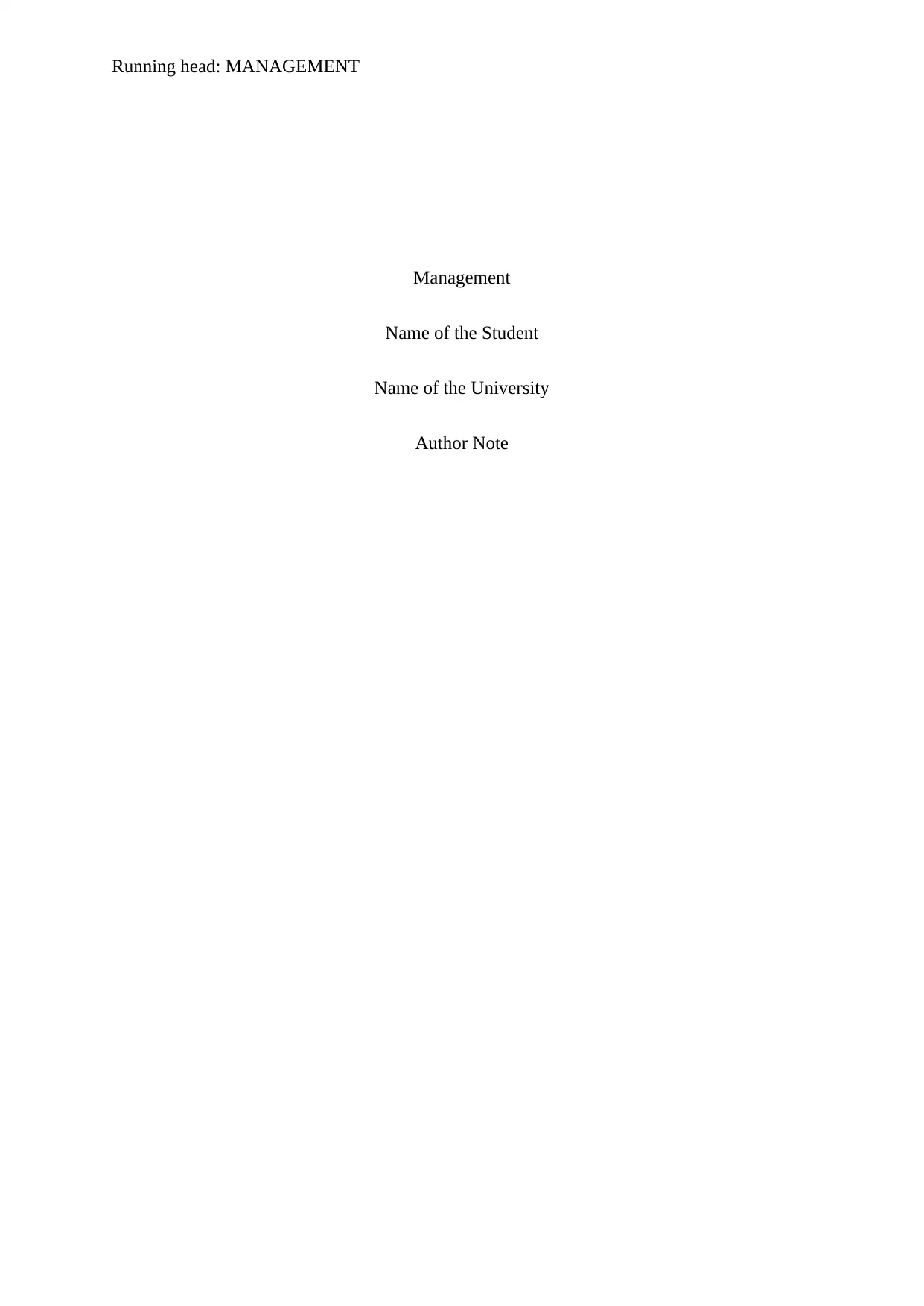
Running head: MANAGEMENT
Management
Name of the Student
Name of the University
Author Note
Management
Name of the Student
Name of the University
Author Note
Paraphrase This Document
Need a fresh take? Get an instant paraphrase of this document with our AI Paraphraser
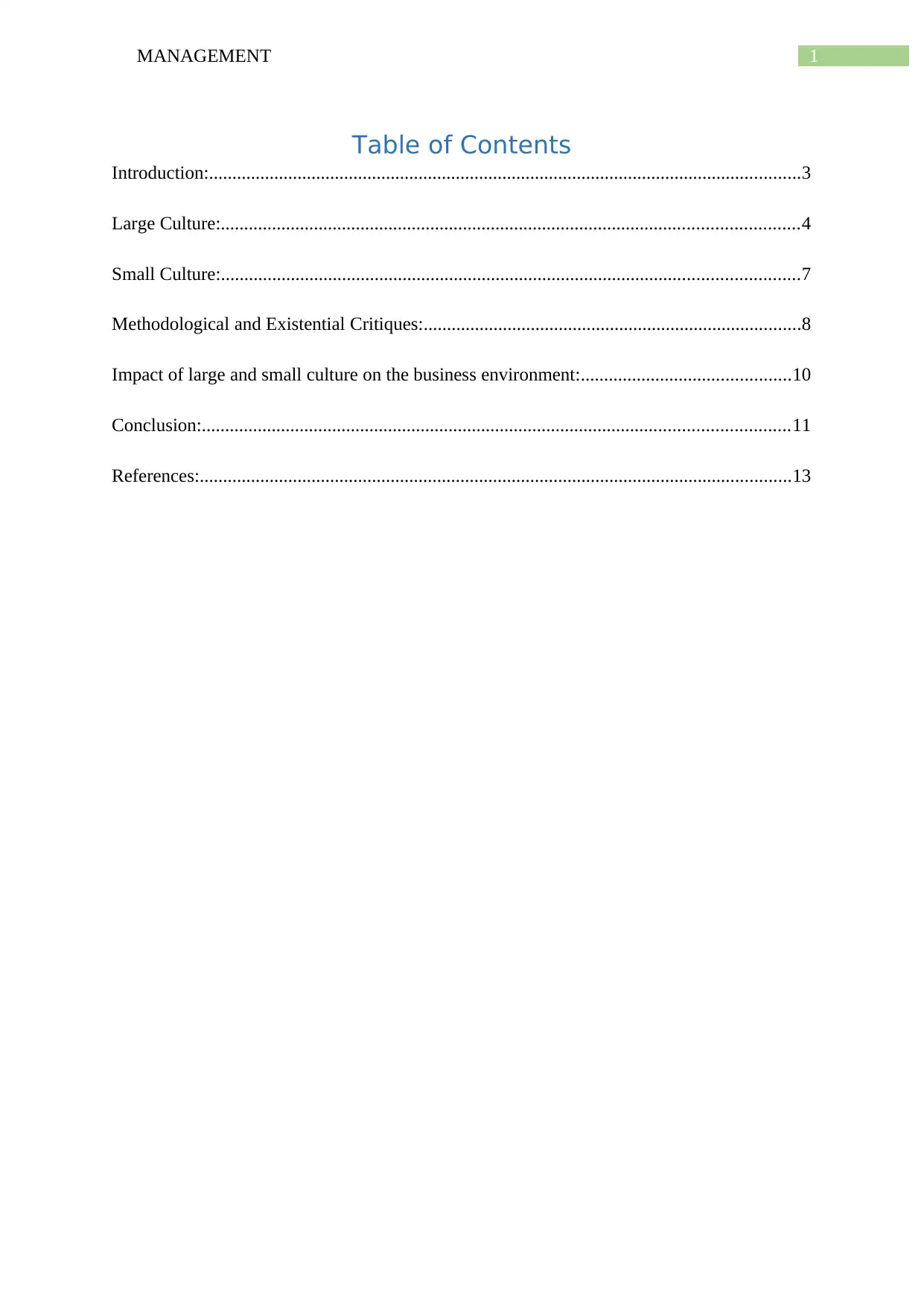
1MANAGEMENT
Table of Contents
Introduction:...............................................................................................................................3
Large Culture:............................................................................................................................4
Small Culture:............................................................................................................................7
Methodological and Existential Critiques:.................................................................................8
Impact of large and small culture on the business environment:.............................................10
Conclusion:..............................................................................................................................11
References:...............................................................................................................................13
Table of Contents
Introduction:...............................................................................................................................3
Large Culture:............................................................................................................................4
Small Culture:............................................................................................................................7
Methodological and Existential Critiques:.................................................................................8
Impact of large and small culture on the business environment:.............................................10
Conclusion:..............................................................................................................................11
References:...............................................................................................................................13
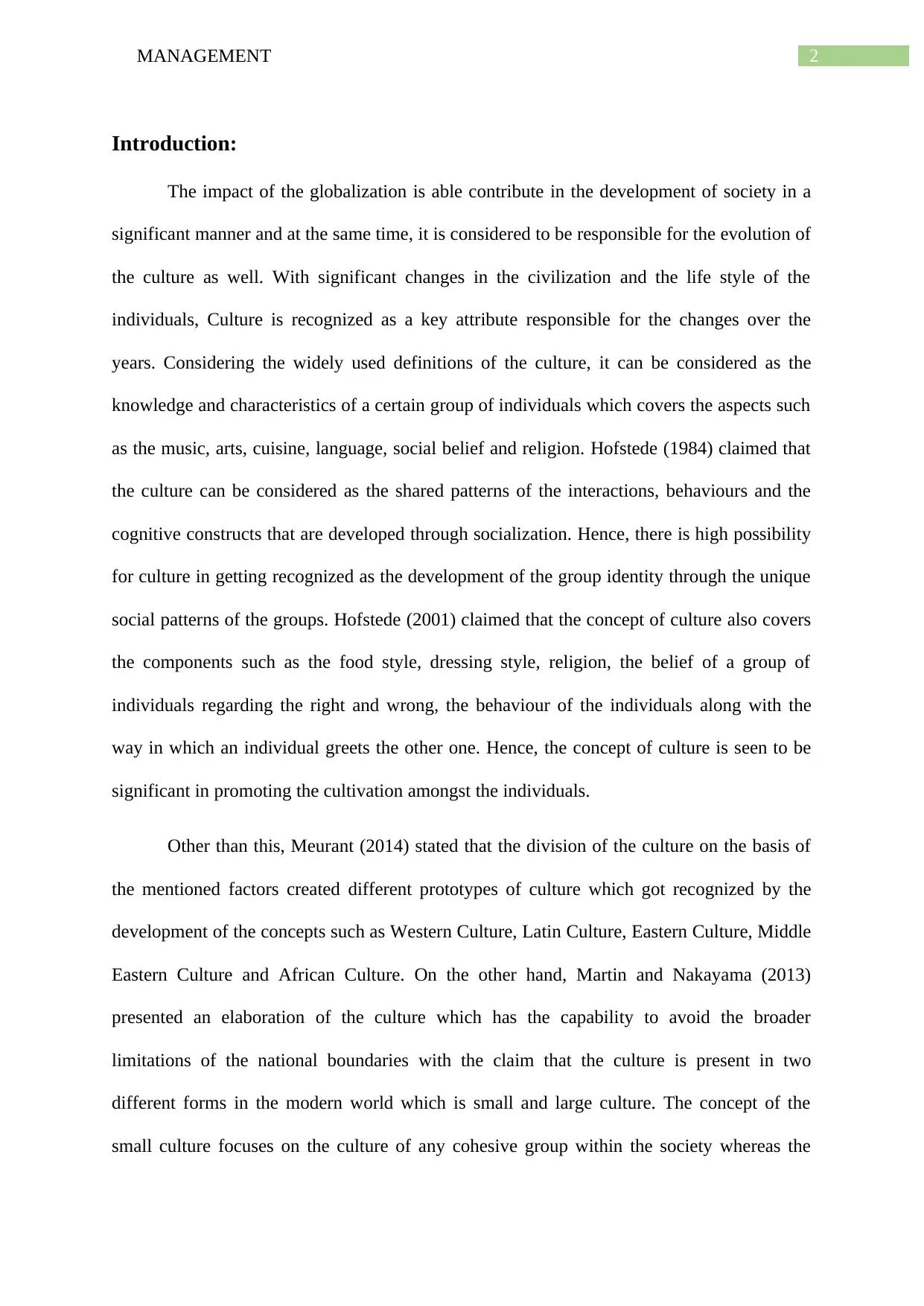
2MANAGEMENT
Introduction:
The impact of the globalization is able contribute in the development of society in a
significant manner and at the same time, it is considered to be responsible for the evolution of
the culture as well. With significant changes in the civilization and the life style of the
individuals, Culture is recognized as a key attribute responsible for the changes over the
years. Considering the widely used definitions of the culture, it can be considered as the
knowledge and characteristics of a certain group of individuals which covers the aspects such
as the music, arts, cuisine, language, social belief and religion. Hofstede (1984) claimed that
the culture can be considered as the shared patterns of the interactions, behaviours and the
cognitive constructs that are developed through socialization. Hence, there is high possibility
for culture in getting recognized as the development of the group identity through the unique
social patterns of the groups. Hofstede (2001) claimed that the concept of culture also covers
the components such as the food style, dressing style, religion, the belief of a group of
individuals regarding the right and wrong, the behaviour of the individuals along with the
way in which an individual greets the other one. Hence, the concept of culture is seen to be
significant in promoting the cultivation amongst the individuals.
Other than this, Meurant (2014) stated that the division of the culture on the basis of
the mentioned factors created different prototypes of culture which got recognized by the
development of the concepts such as Western Culture, Latin Culture, Eastern Culture, Middle
Eastern Culture and African Culture. On the other hand, Martin and Nakayama (2013)
presented an elaboration of the culture which has the capability to avoid the broader
limitations of the national boundaries with the claim that the culture is present in two
different forms in the modern world which is small and large culture. The concept of the
small culture focuses on the culture of any cohesive group within the society whereas the
Introduction:
The impact of the globalization is able contribute in the development of society in a
significant manner and at the same time, it is considered to be responsible for the evolution of
the culture as well. With significant changes in the civilization and the life style of the
individuals, Culture is recognized as a key attribute responsible for the changes over the
years. Considering the widely used definitions of the culture, it can be considered as the
knowledge and characteristics of a certain group of individuals which covers the aspects such
as the music, arts, cuisine, language, social belief and religion. Hofstede (1984) claimed that
the culture can be considered as the shared patterns of the interactions, behaviours and the
cognitive constructs that are developed through socialization. Hence, there is high possibility
for culture in getting recognized as the development of the group identity through the unique
social patterns of the groups. Hofstede (2001) claimed that the concept of culture also covers
the components such as the food style, dressing style, religion, the belief of a group of
individuals regarding the right and wrong, the behaviour of the individuals along with the
way in which an individual greets the other one. Hence, the concept of culture is seen to be
significant in promoting the cultivation amongst the individuals.
Other than this, Meurant (2014) stated that the division of the culture on the basis of
the mentioned factors created different prototypes of culture which got recognized by the
development of the concepts such as Western Culture, Latin Culture, Eastern Culture, Middle
Eastern Culture and African Culture. On the other hand, Martin and Nakayama (2013)
presented an elaboration of the culture which has the capability to avoid the broader
limitations of the national boundaries with the claim that the culture is present in two
different forms in the modern world which is small and large culture. The concept of the
small culture focuses on the culture of any cohesive group within the society whereas the
⊘ This is a preview!⊘
Do you want full access?
Subscribe today to unlock all pages.

Trusted by 1+ million students worldwide
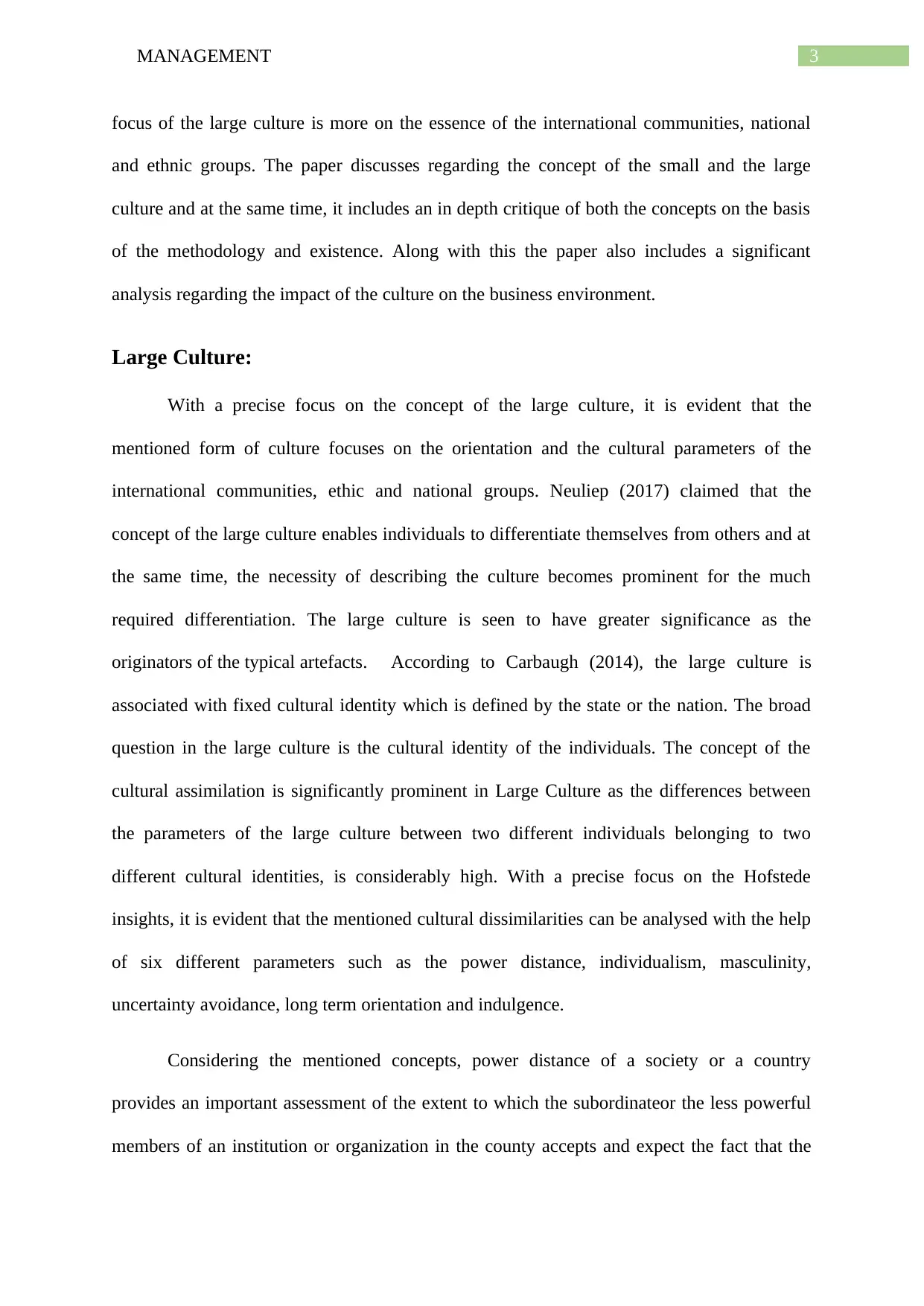
3MANAGEMENT
focus of the large culture is more on the essence of the international communities, national
and ethnic groups. The paper discusses regarding the concept of the small and the large
culture and at the same time, it includes an in depth critique of both the concepts on the basis
of the methodology and existence. Along with this the paper also includes a significant
analysis regarding the impact of the culture on the business environment.
Large Culture:
With a precise focus on the concept of the large culture, it is evident that the
mentioned form of culture focuses on the orientation and the cultural parameters of the
international communities, ethic and national groups. Neuliep (2017) claimed that the
concept of the large culture enables individuals to differentiate themselves from others and at
the same time, the necessity of describing the culture becomes prominent for the much
required differentiation. The large culture is seen to have greater significance as the
originators of the typical artefacts. According to Carbaugh (2014), the large culture is
associated with fixed cultural identity which is defined by the state or the nation. The broad
question in the large culture is the cultural identity of the individuals. The concept of the
cultural assimilation is significantly prominent in Large Culture as the differences between
the parameters of the large culture between two different individuals belonging to two
different cultural identities, is considerably high. With a precise focus on the Hofstede
insights, it is evident that the mentioned cultural dissimilarities can be analysed with the help
of six different parameters such as the power distance, individualism, masculinity,
uncertainty avoidance, long term orientation and indulgence.
Considering the mentioned concepts, power distance of a society or a country
provides an important assessment of the extent to which the subordinateor the less powerful
members of an institution or organization in the county accepts and expect the fact that the
focus of the large culture is more on the essence of the international communities, national
and ethnic groups. The paper discusses regarding the concept of the small and the large
culture and at the same time, it includes an in depth critique of both the concepts on the basis
of the methodology and existence. Along with this the paper also includes a significant
analysis regarding the impact of the culture on the business environment.
Large Culture:
With a precise focus on the concept of the large culture, it is evident that the
mentioned form of culture focuses on the orientation and the cultural parameters of the
international communities, ethic and national groups. Neuliep (2017) claimed that the
concept of the large culture enables individuals to differentiate themselves from others and at
the same time, the necessity of describing the culture becomes prominent for the much
required differentiation. The large culture is seen to have greater significance as the
originators of the typical artefacts. According to Carbaugh (2014), the large culture is
associated with fixed cultural identity which is defined by the state or the nation. The broad
question in the large culture is the cultural identity of the individuals. The concept of the
cultural assimilation is significantly prominent in Large Culture as the differences between
the parameters of the large culture between two different individuals belonging to two
different cultural identities, is considerably high. With a precise focus on the Hofstede
insights, it is evident that the mentioned cultural dissimilarities can be analysed with the help
of six different parameters such as the power distance, individualism, masculinity,
uncertainty avoidance, long term orientation and indulgence.
Considering the mentioned concepts, power distance of a society or a country
provides an important assessment of the extent to which the subordinateor the less powerful
members of an institution or organization in the county accepts and expect the fact that the
Paraphrase This Document
Need a fresh take? Get an instant paraphrase of this document with our AI Paraphraser
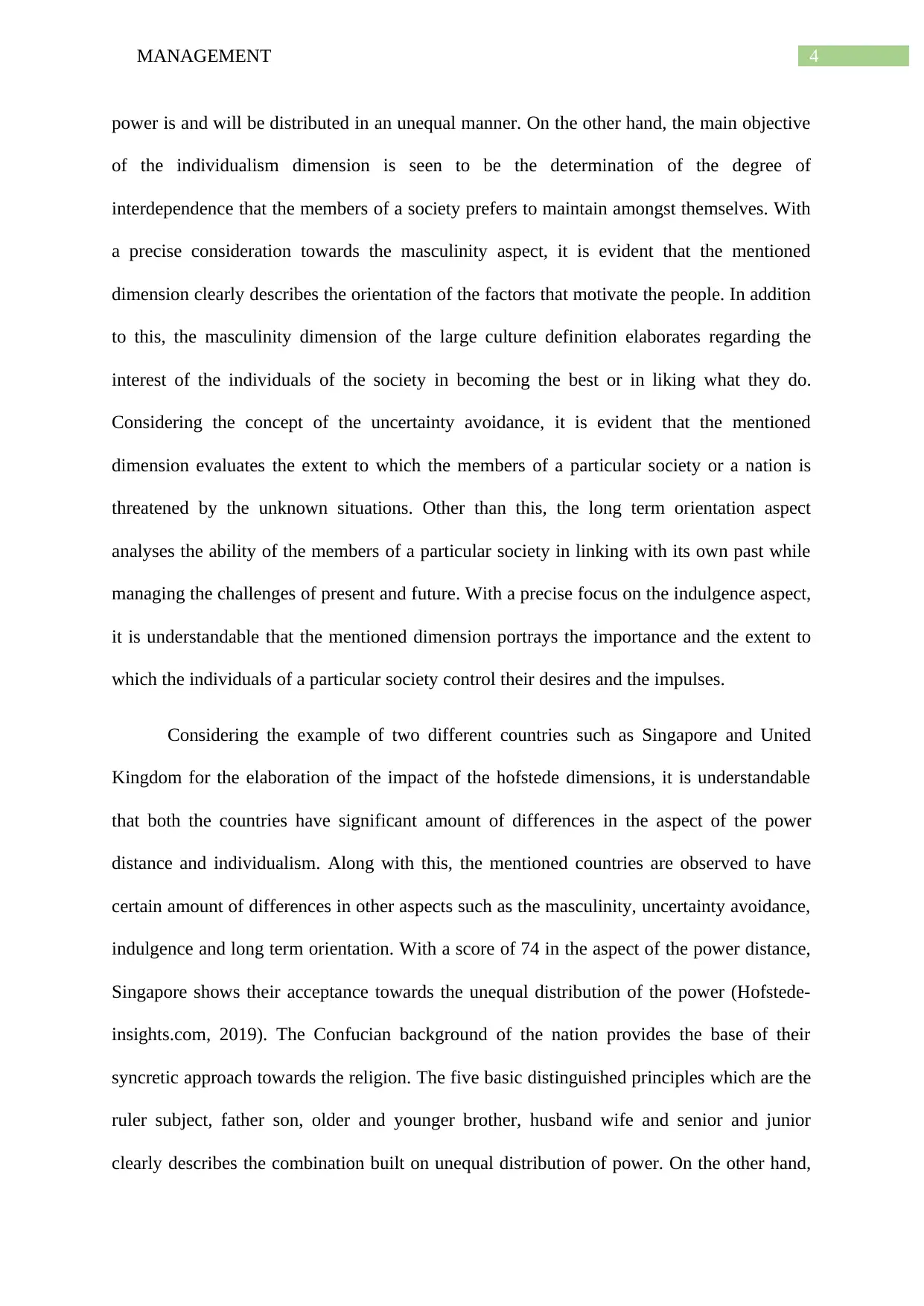
4MANAGEMENT
power is and will be distributed in an unequal manner. On the other hand, the main objective
of the individualism dimension is seen to be the determination of the degree of
interdependence that the members of a society prefers to maintain amongst themselves. With
a precise consideration towards the masculinity aspect, it is evident that the mentioned
dimension clearly describes the orientation of the factors that motivate the people. In addition
to this, the masculinity dimension of the large culture definition elaborates regarding the
interest of the individuals of the society in becoming the best or in liking what they do.
Considering the concept of the uncertainty avoidance, it is evident that the mentioned
dimension evaluates the extent to which the members of a particular society or a nation is
threatened by the unknown situations. Other than this, the long term orientation aspect
analyses the ability of the members of a particular society in linking with its own past while
managing the challenges of present and future. With a precise focus on the indulgence aspect,
it is understandable that the mentioned dimension portrays the importance and the extent to
which the individuals of a particular society control their desires and the impulses.
Considering the example of two different countries such as Singapore and United
Kingdom for the elaboration of the impact of the hofstede dimensions, it is understandable
that both the countries have significant amount of differences in the aspect of the power
distance and individualism. Along with this, the mentioned countries are observed to have
certain amount of differences in other aspects such as the masculinity, uncertainty avoidance,
indulgence and long term orientation. With a score of 74 in the aspect of the power distance,
Singapore shows their acceptance towards the unequal distribution of the power (Hofstede-
insights.com, 2019). The Confucian background of the nation provides the base of their
syncretic approach towards the religion. The five basic distinguished principles which are the
ruler subject, father son, older and younger brother, husband wife and senior and junior
clearly describes the combination built on unequal distribution of power. On the other hand,
power is and will be distributed in an unequal manner. On the other hand, the main objective
of the individualism dimension is seen to be the determination of the degree of
interdependence that the members of a society prefers to maintain amongst themselves. With
a precise consideration towards the masculinity aspect, it is evident that the mentioned
dimension clearly describes the orientation of the factors that motivate the people. In addition
to this, the masculinity dimension of the large culture definition elaborates regarding the
interest of the individuals of the society in becoming the best or in liking what they do.
Considering the concept of the uncertainty avoidance, it is evident that the mentioned
dimension evaluates the extent to which the members of a particular society or a nation is
threatened by the unknown situations. Other than this, the long term orientation aspect
analyses the ability of the members of a particular society in linking with its own past while
managing the challenges of present and future. With a precise focus on the indulgence aspect,
it is understandable that the mentioned dimension portrays the importance and the extent to
which the individuals of a particular society control their desires and the impulses.
Considering the example of two different countries such as Singapore and United
Kingdom for the elaboration of the impact of the hofstede dimensions, it is understandable
that both the countries have significant amount of differences in the aspect of the power
distance and individualism. Along with this, the mentioned countries are observed to have
certain amount of differences in other aspects such as the masculinity, uncertainty avoidance,
indulgence and long term orientation. With a score of 74 in the aspect of the power distance,
Singapore shows their acceptance towards the unequal distribution of the power (Hofstede-
insights.com, 2019). The Confucian background of the nation provides the base of their
syncretic approach towards the religion. The five basic distinguished principles which are the
ruler subject, father son, older and younger brother, husband wife and senior and junior
clearly describes the combination built on unequal distribution of power. On the other hand,
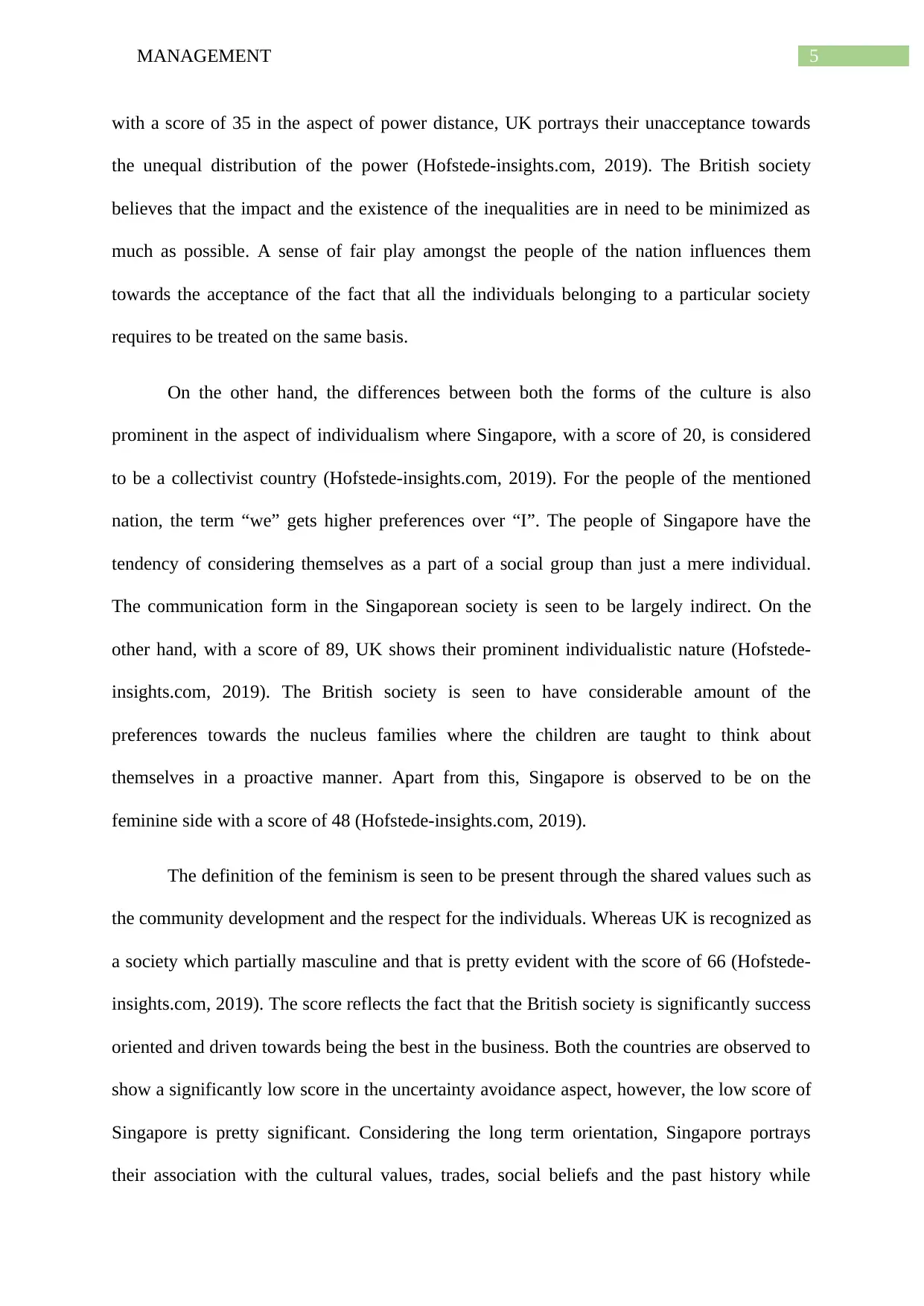
5MANAGEMENT
with a score of 35 in the aspect of power distance, UK portrays their unacceptance towards
the unequal distribution of the power (Hofstede-insights.com, 2019). The British society
believes that the impact and the existence of the inequalities are in need to be minimized as
much as possible. A sense of fair play amongst the people of the nation influences them
towards the acceptance of the fact that all the individuals belonging to a particular society
requires to be treated on the same basis.
On the other hand, the differences between both the forms of the culture is also
prominent in the aspect of individualism where Singapore, with a score of 20, is considered
to be a collectivist country (Hofstede-insights.com, 2019). For the people of the mentioned
nation, the term “we” gets higher preferences over “I”. The people of Singapore have the
tendency of considering themselves as a part of a social group than just a mere individual.
The communication form in the Singaporean society is seen to be largely indirect. On the
other hand, with a score of 89, UK shows their prominent individualistic nature (Hofstede-
insights.com, 2019). The British society is seen to have considerable amount of the
preferences towards the nucleus families where the children are taught to think about
themselves in a proactive manner. Apart from this, Singapore is observed to be on the
feminine side with a score of 48 (Hofstede-insights.com, 2019).
The definition of the feminism is seen to be present through the shared values such as
the community development and the respect for the individuals. Whereas UK is recognized as
a society which partially masculine and that is pretty evident with the score of 66 (Hofstede-
insights.com, 2019). The score reflects the fact that the British society is significantly success
oriented and driven towards being the best in the business. Both the countries are observed to
show a significantly low score in the uncertainty avoidance aspect, however, the low score of
Singapore is pretty significant. Considering the long term orientation, Singapore portrays
their association with the cultural values, trades, social beliefs and the past history while
with a score of 35 in the aspect of power distance, UK portrays their unacceptance towards
the unequal distribution of the power (Hofstede-insights.com, 2019). The British society
believes that the impact and the existence of the inequalities are in need to be minimized as
much as possible. A sense of fair play amongst the people of the nation influences them
towards the acceptance of the fact that all the individuals belonging to a particular society
requires to be treated on the same basis.
On the other hand, the differences between both the forms of the culture is also
prominent in the aspect of individualism where Singapore, with a score of 20, is considered
to be a collectivist country (Hofstede-insights.com, 2019). For the people of the mentioned
nation, the term “we” gets higher preferences over “I”. The people of Singapore have the
tendency of considering themselves as a part of a social group than just a mere individual.
The communication form in the Singaporean society is seen to be largely indirect. On the
other hand, with a score of 89, UK shows their prominent individualistic nature (Hofstede-
insights.com, 2019). The British society is seen to have considerable amount of the
preferences towards the nucleus families where the children are taught to think about
themselves in a proactive manner. Apart from this, Singapore is observed to be on the
feminine side with a score of 48 (Hofstede-insights.com, 2019).
The definition of the feminism is seen to be present through the shared values such as
the community development and the respect for the individuals. Whereas UK is recognized as
a society which partially masculine and that is pretty evident with the score of 66 (Hofstede-
insights.com, 2019). The score reflects the fact that the British society is significantly success
oriented and driven towards being the best in the business. Both the countries are observed to
show a significantly low score in the uncertainty avoidance aspect, however, the low score of
Singapore is pretty significant. Considering the long term orientation, Singapore portrays
their association with the cultural values, trades, social beliefs and the past history while
⊘ This is a preview!⊘
Do you want full access?
Subscribe today to unlock all pages.

Trusted by 1+ million students worldwide
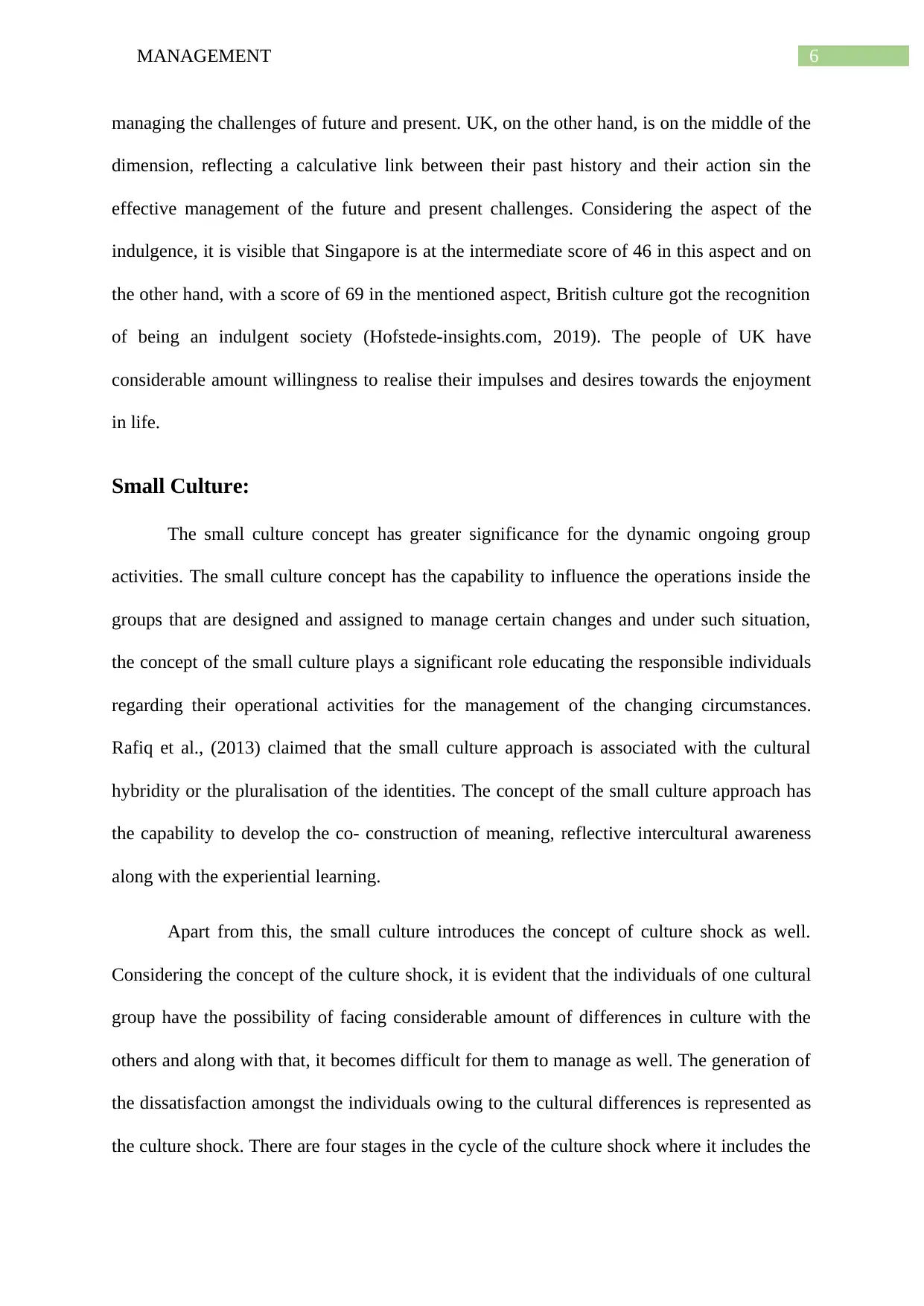
6MANAGEMENT
managing the challenges of future and present. UK, on the other hand, is on the middle of the
dimension, reflecting a calculative link between their past history and their action sin the
effective management of the future and present challenges. Considering the aspect of the
indulgence, it is visible that Singapore is at the intermediate score of 46 in this aspect and on
the other hand, with a score of 69 in the mentioned aspect, British culture got the recognition
of being an indulgent society (Hofstede-insights.com, 2019). The people of UK have
considerable amount willingness to realise their impulses and desires towards the enjoyment
in life.
Small Culture:
The small culture concept has greater significance for the dynamic ongoing group
activities. The small culture concept has the capability to influence the operations inside the
groups that are designed and assigned to manage certain changes and under such situation,
the concept of the small culture plays a significant role educating the responsible individuals
regarding their operational activities for the management of the changing circumstances.
Rafiq et al., (2013) claimed that the small culture approach is associated with the cultural
hybridity or the pluralisation of the identities. The concept of the small culture approach has
the capability to develop the co- construction of meaning, reflective intercultural awareness
along with the experiential learning.
Apart from this, the small culture introduces the concept of culture shock as well.
Considering the concept of the culture shock, it is evident that the individuals of one cultural
group have the possibility of facing considerable amount of differences in culture with the
others and along with that, it becomes difficult for them to manage as well. The generation of
the dissatisfaction amongst the individuals owing to the cultural differences is represented as
the culture shock. There are four stages in the cycle of the culture shock where it includes the
managing the challenges of future and present. UK, on the other hand, is on the middle of the
dimension, reflecting a calculative link between their past history and their action sin the
effective management of the future and present challenges. Considering the aspect of the
indulgence, it is visible that Singapore is at the intermediate score of 46 in this aspect and on
the other hand, with a score of 69 in the mentioned aspect, British culture got the recognition
of being an indulgent society (Hofstede-insights.com, 2019). The people of UK have
considerable amount willingness to realise their impulses and desires towards the enjoyment
in life.
Small Culture:
The small culture concept has greater significance for the dynamic ongoing group
activities. The small culture concept has the capability to influence the operations inside the
groups that are designed and assigned to manage certain changes and under such situation,
the concept of the small culture plays a significant role educating the responsible individuals
regarding their operational activities for the management of the changing circumstances.
Rafiq et al., (2013) claimed that the small culture approach is associated with the cultural
hybridity or the pluralisation of the identities. The concept of the small culture approach has
the capability to develop the co- construction of meaning, reflective intercultural awareness
along with the experiential learning.
Apart from this, the small culture introduces the concept of culture shock as well.
Considering the concept of the culture shock, it is evident that the individuals of one cultural
group have the possibility of facing considerable amount of differences in culture with the
others and along with that, it becomes difficult for them to manage as well. The generation of
the dissatisfaction amongst the individuals owing to the cultural differences is represented as
the culture shock. There are four stages in the cycle of the culture shock where it includes the
Paraphrase This Document
Need a fresh take? Get an instant paraphrase of this document with our AI Paraphraser
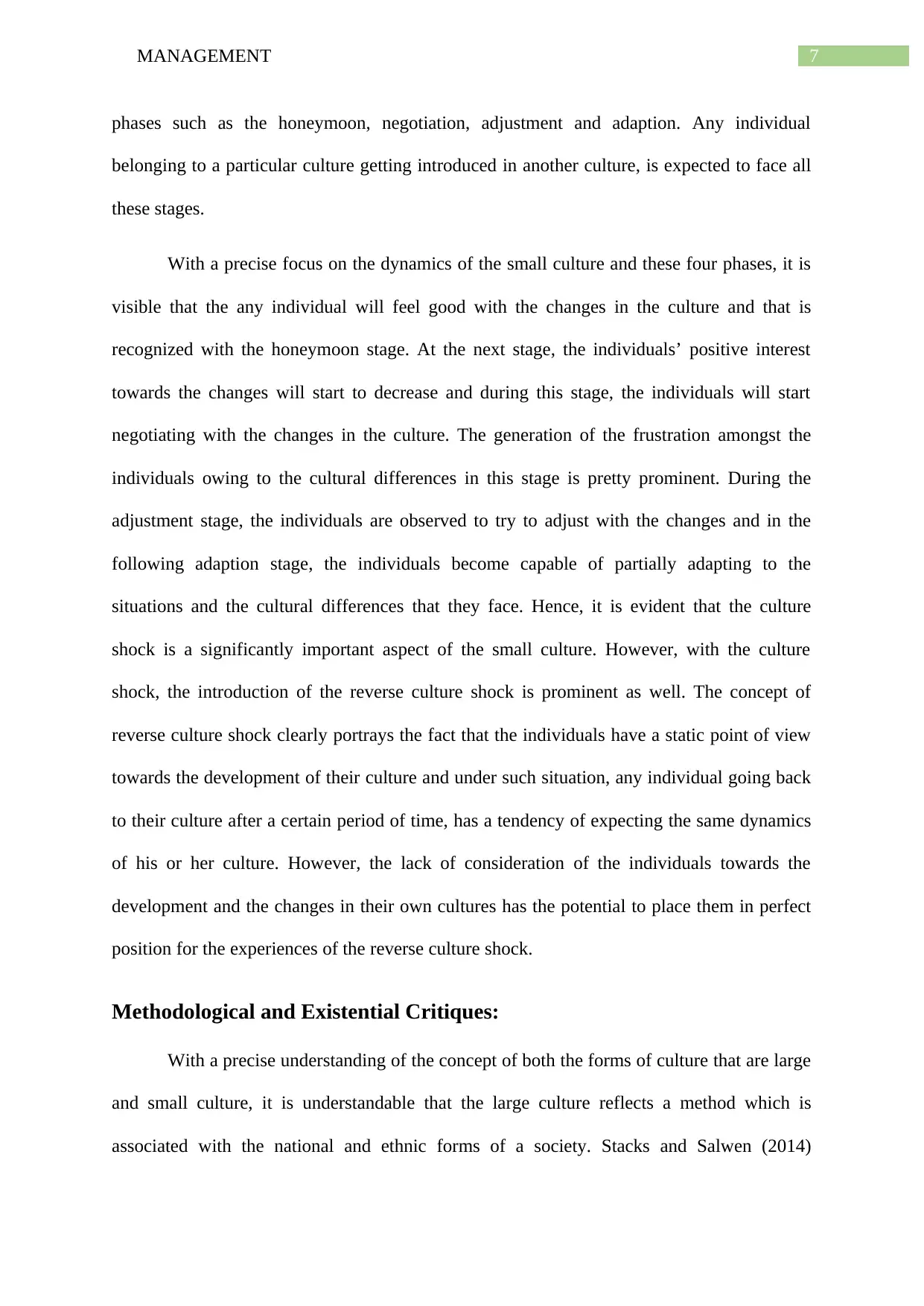
7MANAGEMENT
phases such as the honeymoon, negotiation, adjustment and adaption. Any individual
belonging to a particular culture getting introduced in another culture, is expected to face all
these stages.
With a precise focus on the dynamics of the small culture and these four phases, it is
visible that the any individual will feel good with the changes in the culture and that is
recognized with the honeymoon stage. At the next stage, the individuals’ positive interest
towards the changes will start to decrease and during this stage, the individuals will start
negotiating with the changes in the culture. The generation of the frustration amongst the
individuals owing to the cultural differences in this stage is pretty prominent. During the
adjustment stage, the individuals are observed to try to adjust with the changes and in the
following adaption stage, the individuals become capable of partially adapting to the
situations and the cultural differences that they face. Hence, it is evident that the culture
shock is a significantly important aspect of the small culture. However, with the culture
shock, the introduction of the reverse culture shock is prominent as well. The concept of
reverse culture shock clearly portrays the fact that the individuals have a static point of view
towards the development of their culture and under such situation, any individual going back
to their culture after a certain period of time, has a tendency of expecting the same dynamics
of his or her culture. However, the lack of consideration of the individuals towards the
development and the changes in their own cultures has the potential to place them in perfect
position for the experiences of the reverse culture shock.
Methodological and Existential Critiques:
With a precise understanding of the concept of both the forms of culture that are large
and small culture, it is understandable that the large culture reflects a method which is
associated with the national and ethnic forms of a society. Stacks and Salwen (2014)
phases such as the honeymoon, negotiation, adjustment and adaption. Any individual
belonging to a particular culture getting introduced in another culture, is expected to face all
these stages.
With a precise focus on the dynamics of the small culture and these four phases, it is
visible that the any individual will feel good with the changes in the culture and that is
recognized with the honeymoon stage. At the next stage, the individuals’ positive interest
towards the changes will start to decrease and during this stage, the individuals will start
negotiating with the changes in the culture. The generation of the frustration amongst the
individuals owing to the cultural differences in this stage is pretty prominent. During the
adjustment stage, the individuals are observed to try to adjust with the changes and in the
following adaption stage, the individuals become capable of partially adapting to the
situations and the cultural differences that they face. Hence, it is evident that the culture
shock is a significantly important aspect of the small culture. However, with the culture
shock, the introduction of the reverse culture shock is prominent as well. The concept of
reverse culture shock clearly portrays the fact that the individuals have a static point of view
towards the development of their culture and under such situation, any individual going back
to their culture after a certain period of time, has a tendency of expecting the same dynamics
of his or her culture. However, the lack of consideration of the individuals towards the
development and the changes in their own cultures has the potential to place them in perfect
position for the experiences of the reverse culture shock.
Methodological and Existential Critiques:
With a precise understanding of the concept of both the forms of culture that are large
and small culture, it is understandable that the large culture reflects a method which is
associated with the national and ethnic forms of a society. Stacks and Salwen (2014)
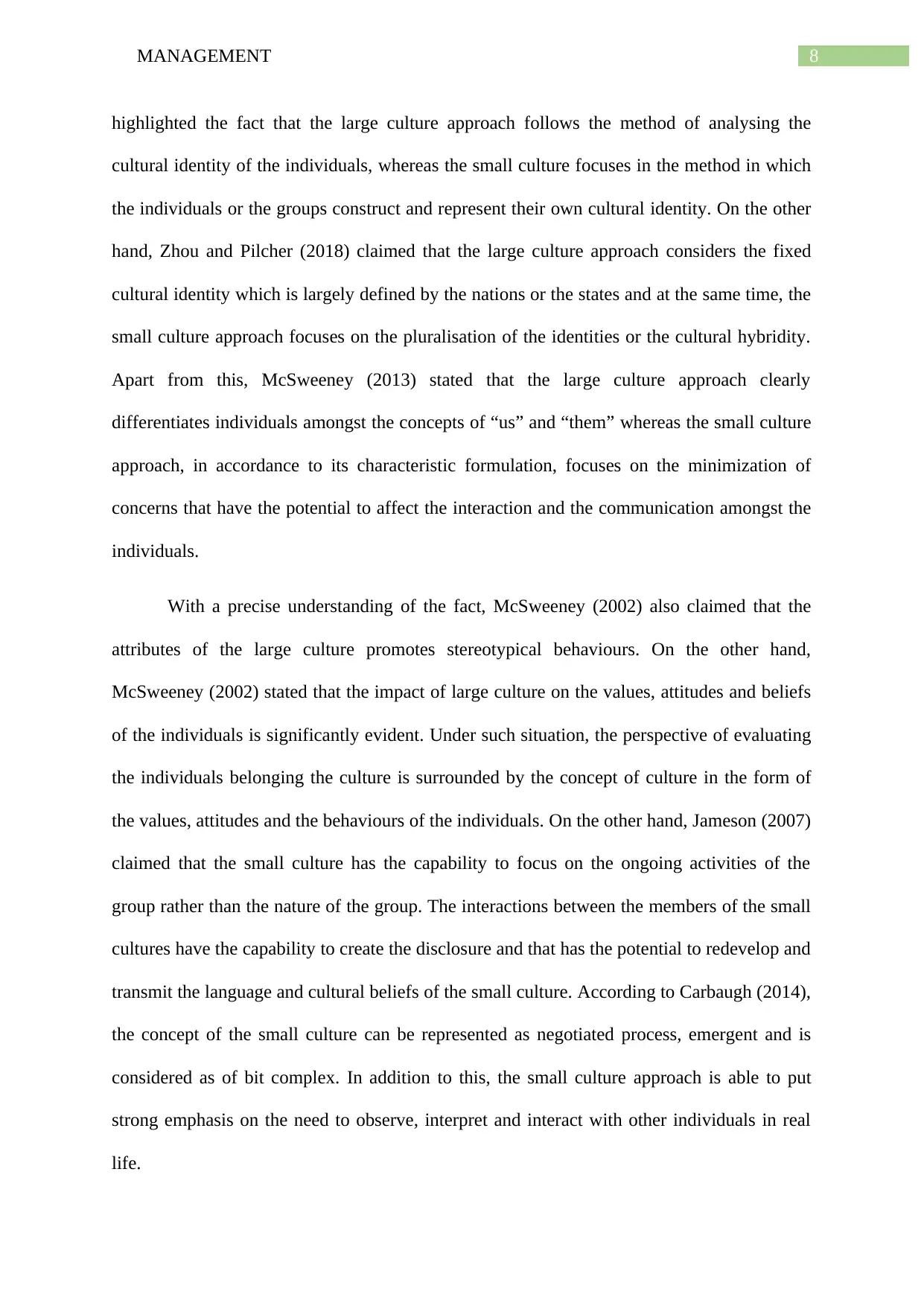
8MANAGEMENT
highlighted the fact that the large culture approach follows the method of analysing the
cultural identity of the individuals, whereas the small culture focuses in the method in which
the individuals or the groups construct and represent their own cultural identity. On the other
hand, Zhou and Pilcher (2018) claimed that the large culture approach considers the fixed
cultural identity which is largely defined by the nations or the states and at the same time, the
small culture approach focuses on the pluralisation of the identities or the cultural hybridity.
Apart from this, McSweeney (2013) stated that the large culture approach clearly
differentiates individuals amongst the concepts of “us” and “them” whereas the small culture
approach, in accordance to its characteristic formulation, focuses on the minimization of
concerns that have the potential to affect the interaction and the communication amongst the
individuals.
With a precise understanding of the fact, McSweeney (2002) also claimed that the
attributes of the large culture promotes stereotypical behaviours. On the other hand,
McSweeney (2002) stated that the impact of large culture on the values, attitudes and beliefs
of the individuals is significantly evident. Under such situation, the perspective of evaluating
the individuals belonging the culture is surrounded by the concept of culture in the form of
the values, attitudes and the behaviours of the individuals. On the other hand, Jameson (2007)
claimed that the small culture has the capability to focus on the ongoing activities of the
group rather than the nature of the group. The interactions between the members of the small
cultures have the capability to create the disclosure and that has the potential to redevelop and
transmit the language and cultural beliefs of the small culture. According to Carbaugh (2014),
the concept of the small culture can be represented as negotiated process, emergent and is
considered as of bit complex. In addition to this, the small culture approach is able to put
strong emphasis on the need to observe, interpret and interact with other individuals in real
life.
highlighted the fact that the large culture approach follows the method of analysing the
cultural identity of the individuals, whereas the small culture focuses in the method in which
the individuals or the groups construct and represent their own cultural identity. On the other
hand, Zhou and Pilcher (2018) claimed that the large culture approach considers the fixed
cultural identity which is largely defined by the nations or the states and at the same time, the
small culture approach focuses on the pluralisation of the identities or the cultural hybridity.
Apart from this, McSweeney (2013) stated that the large culture approach clearly
differentiates individuals amongst the concepts of “us” and “them” whereas the small culture
approach, in accordance to its characteristic formulation, focuses on the minimization of
concerns that have the potential to affect the interaction and the communication amongst the
individuals.
With a precise understanding of the fact, McSweeney (2002) also claimed that the
attributes of the large culture promotes stereotypical behaviours. On the other hand,
McSweeney (2002) stated that the impact of large culture on the values, attitudes and beliefs
of the individuals is significantly evident. Under such situation, the perspective of evaluating
the individuals belonging the culture is surrounded by the concept of culture in the form of
the values, attitudes and the behaviours of the individuals. On the other hand, Jameson (2007)
claimed that the small culture has the capability to focus on the ongoing activities of the
group rather than the nature of the group. The interactions between the members of the small
cultures have the capability to create the disclosure and that has the potential to redevelop and
transmit the language and cultural beliefs of the small culture. According to Carbaugh (2014),
the concept of the small culture can be represented as negotiated process, emergent and is
considered as of bit complex. In addition to this, the small culture approach is able to put
strong emphasis on the need to observe, interpret and interact with other individuals in real
life.
⊘ This is a preview!⊘
Do you want full access?
Subscribe today to unlock all pages.

Trusted by 1+ million students worldwide
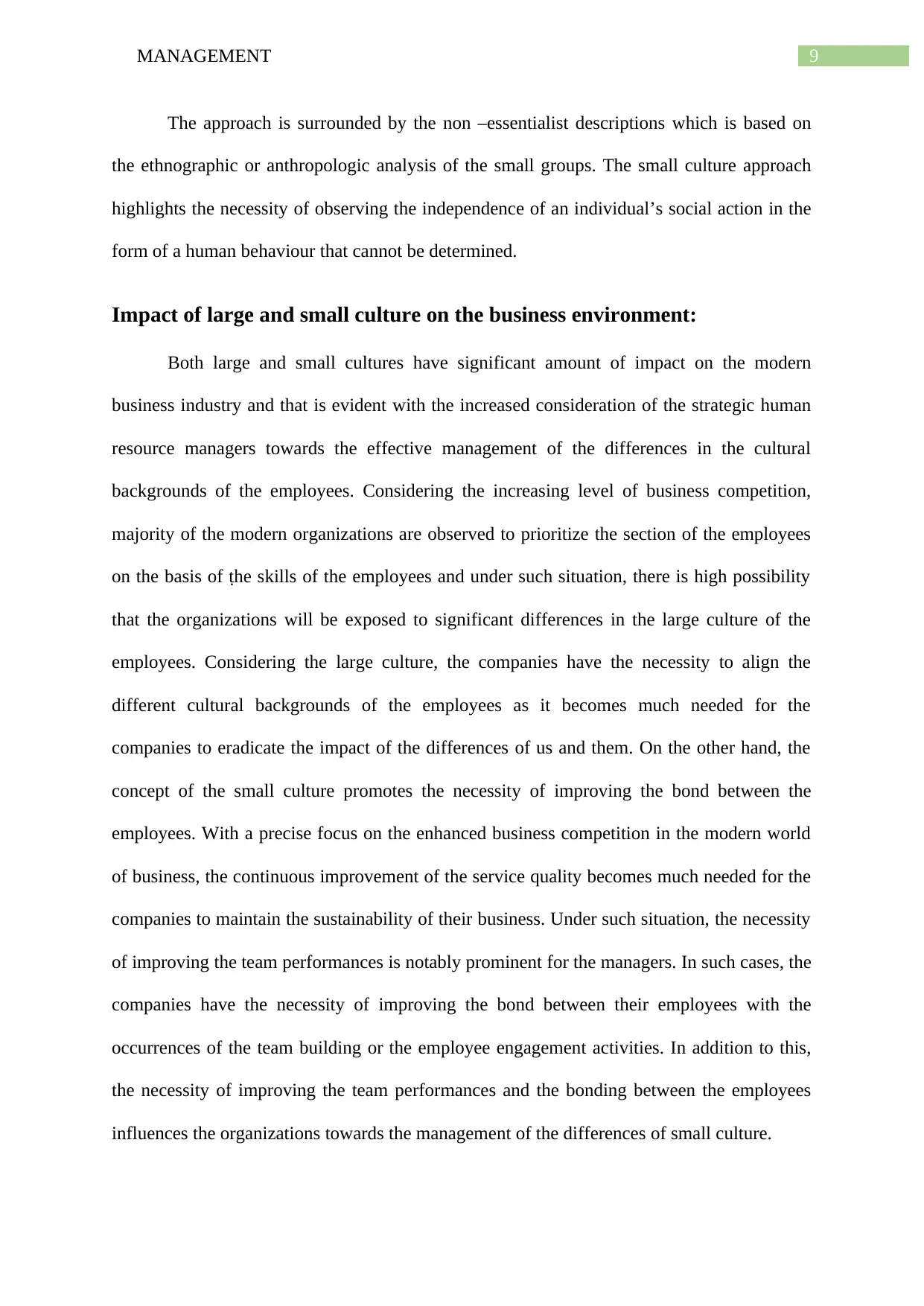
9MANAGEMENT
The approach is surrounded by the non –essentialist descriptions which is based on
the ethnographic or anthropologic analysis of the small groups. The small culture approach
highlights the necessity of observing the independence of an individual’s social action in the
form of a human behaviour that cannot be determined.
Impact of large and small culture on the business environment:
Both large and small cultures have significant amount of impact on the modern
business industry and that is evident with the increased consideration of the strategic human
resource managers towards the effective management of the differences in the cultural
backgrounds of the employees. Considering the increasing level of business competition,
majority of the modern organizations are observed to prioritize the section of the employees
on the basis of ṭhe skills of the employees and under such situation, there is high possibility
that the organizations will be exposed to significant differences in the large culture of the
employees. Considering the large culture, the companies have the necessity to align the
different cultural backgrounds of the employees as it becomes much needed for the
companies to eradicate the impact of the differences of us and them. On the other hand, the
concept of the small culture promotes the necessity of improving the bond between the
employees. With a precise focus on the enhanced business competition in the modern world
of business, the continuous improvement of the service quality becomes much needed for the
companies to maintain the sustainability of their business. Under such situation, the necessity
of improving the team performances is notably prominent for the managers. In such cases, the
companies have the necessity of improving the bond between their employees with the
occurrences of the team building or the employee engagement activities. In addition to this,
the necessity of improving the team performances and the bonding between the employees
influences the organizations towards the management of the differences of small culture.
The approach is surrounded by the non –essentialist descriptions which is based on
the ethnographic or anthropologic analysis of the small groups. The small culture approach
highlights the necessity of observing the independence of an individual’s social action in the
form of a human behaviour that cannot be determined.
Impact of large and small culture on the business environment:
Both large and small cultures have significant amount of impact on the modern
business industry and that is evident with the increased consideration of the strategic human
resource managers towards the effective management of the differences in the cultural
backgrounds of the employees. Considering the increasing level of business competition,
majority of the modern organizations are observed to prioritize the section of the employees
on the basis of ṭhe skills of the employees and under such situation, there is high possibility
that the organizations will be exposed to significant differences in the large culture of the
employees. Considering the large culture, the companies have the necessity to align the
different cultural backgrounds of the employees as it becomes much needed for the
companies to eradicate the impact of the differences of us and them. On the other hand, the
concept of the small culture promotes the necessity of improving the bond between the
employees. With a precise focus on the enhanced business competition in the modern world
of business, the continuous improvement of the service quality becomes much needed for the
companies to maintain the sustainability of their business. Under such situation, the necessity
of improving the team performances is notably prominent for the managers. In such cases, the
companies have the necessity of improving the bond between their employees with the
occurrences of the team building or the employee engagement activities. In addition to this,
the necessity of improving the team performances and the bonding between the employees
influences the organizations towards the management of the differences of small culture.
Paraphrase This Document
Need a fresh take? Get an instant paraphrase of this document with our AI Paraphraser
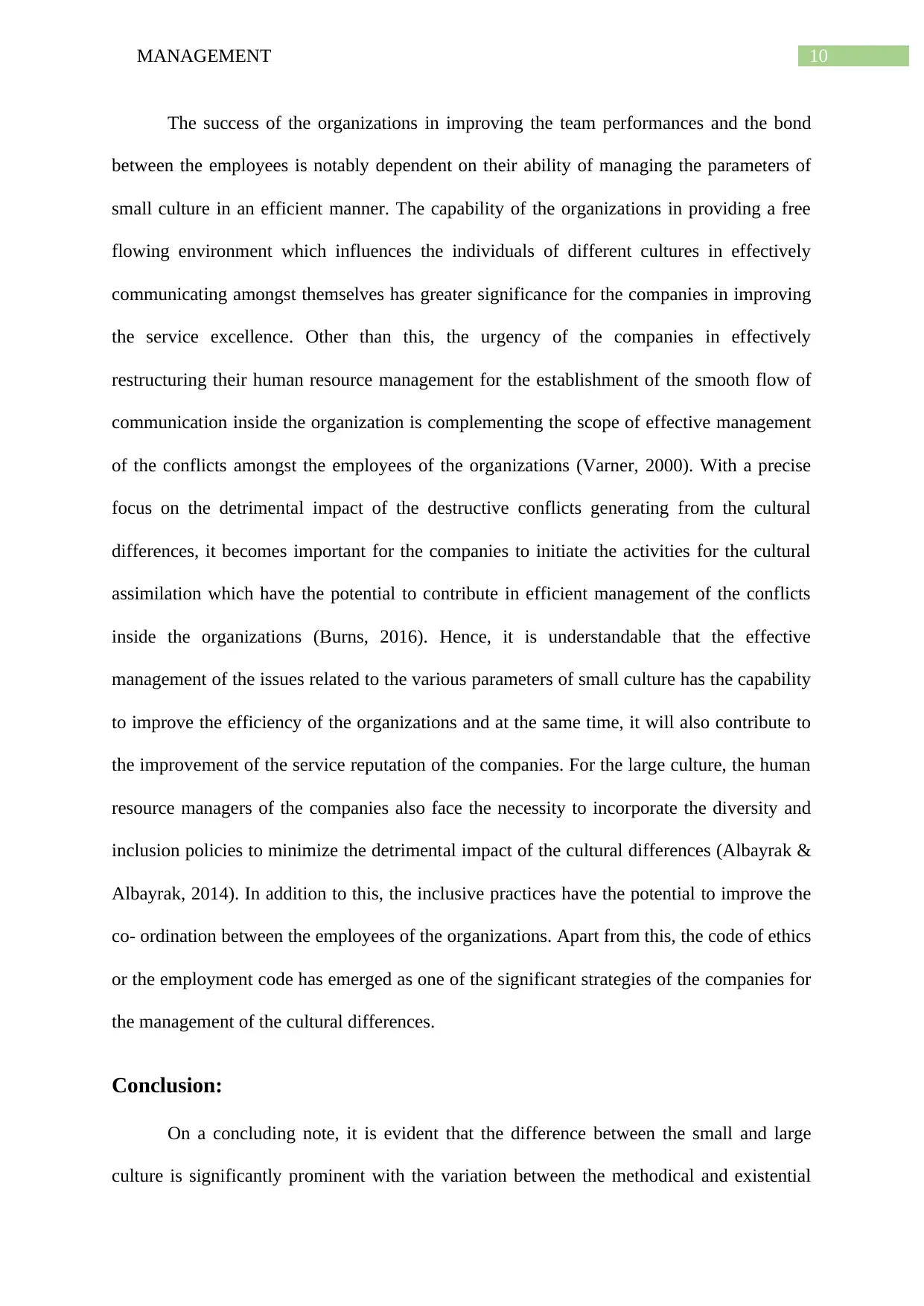
10MANAGEMENT
The success of the organizations in improving the team performances and the bond
between the employees is notably dependent on their ability of managing the parameters of
small culture in an efficient manner. The capability of the organizations in providing a free
flowing environment which influences the individuals of different cultures in effectively
communicating amongst themselves has greater significance for the companies in improving
the service excellence. Other than this, the urgency of the companies in effectively
restructuring their human resource management for the establishment of the smooth flow of
communication inside the organization is complementing the scope of effective management
of the conflicts amongst the employees of the organizations (Varner, 2000). With a precise
focus on the detrimental impact of the destructive conflicts generating from the cultural
differences, it becomes important for the companies to initiate the activities for the cultural
assimilation which have the potential to contribute in efficient management of the conflicts
inside the organizations (Burns, 2016). Hence, it is understandable that the effective
management of the issues related to the various parameters of small culture has the capability
to improve the efficiency of the organizations and at the same time, it will also contribute to
the improvement of the service reputation of the companies. For the large culture, the human
resource managers of the companies also face the necessity to incorporate the diversity and
inclusion policies to minimize the detrimental impact of the cultural differences (Albayrak &
Albayrak, 2014). In addition to this, the inclusive practices have the potential to improve the
co- ordination between the employees of the organizations. Apart from this, the code of ethics
or the employment code has emerged as one of the significant strategies of the companies for
the management of the cultural differences.
Conclusion:
On a concluding note, it is evident that the difference between the small and large
culture is significantly prominent with the variation between the methodical and existential
The success of the organizations in improving the team performances and the bond
between the employees is notably dependent on their ability of managing the parameters of
small culture in an efficient manner. The capability of the organizations in providing a free
flowing environment which influences the individuals of different cultures in effectively
communicating amongst themselves has greater significance for the companies in improving
the service excellence. Other than this, the urgency of the companies in effectively
restructuring their human resource management for the establishment of the smooth flow of
communication inside the organization is complementing the scope of effective management
of the conflicts amongst the employees of the organizations (Varner, 2000). With a precise
focus on the detrimental impact of the destructive conflicts generating from the cultural
differences, it becomes important for the companies to initiate the activities for the cultural
assimilation which have the potential to contribute in efficient management of the conflicts
inside the organizations (Burns, 2016). Hence, it is understandable that the effective
management of the issues related to the various parameters of small culture has the capability
to improve the efficiency of the organizations and at the same time, it will also contribute to
the improvement of the service reputation of the companies. For the large culture, the human
resource managers of the companies also face the necessity to incorporate the diversity and
inclusion policies to minimize the detrimental impact of the cultural differences (Albayrak &
Albayrak, 2014). In addition to this, the inclusive practices have the potential to improve the
co- ordination between the employees of the organizations. Apart from this, the code of ethics
or the employment code has emerged as one of the significant strategies of the companies for
the management of the cultural differences.
Conclusion:
On a concluding note, it is evident that the difference between the small and large
culture is significantly prominent with the variation between the methodical and existential
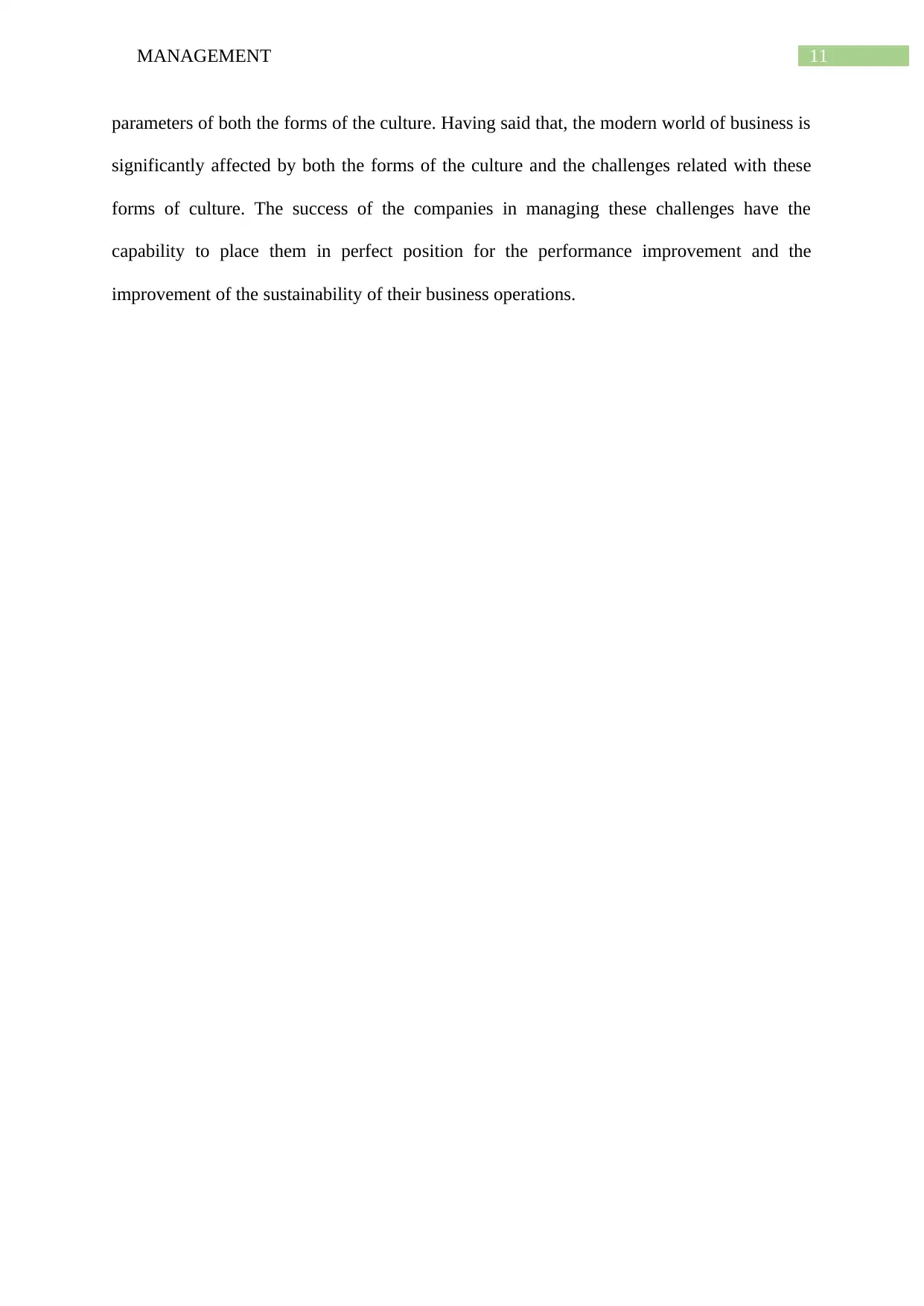
11MANAGEMENT
parameters of both the forms of the culture. Having said that, the modern world of business is
significantly affected by both the forms of the culture and the challenges related with these
forms of culture. The success of the companies in managing these challenges have the
capability to place them in perfect position for the performance improvement and the
improvement of the sustainability of their business operations.
parameters of both the forms of the culture. Having said that, the modern world of business is
significantly affected by both the forms of the culture and the challenges related with these
forms of culture. The success of the companies in managing these challenges have the
capability to place them in perfect position for the performance improvement and the
improvement of the sustainability of their business operations.
⊘ This is a preview!⊘
Do you want full access?
Subscribe today to unlock all pages.

Trusted by 1+ million students worldwide
1 out of 14
Related Documents
Your All-in-One AI-Powered Toolkit for Academic Success.
+13062052269
info@desklib.com
Available 24*7 on WhatsApp / Email
![[object Object]](/_next/static/media/star-bottom.7253800d.svg)
Unlock your academic potential
Copyright © 2020–2025 A2Z Services. All Rights Reserved. Developed and managed by ZUCOL.




